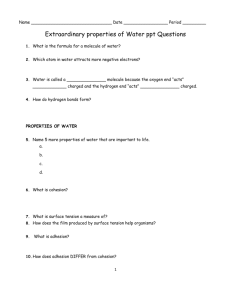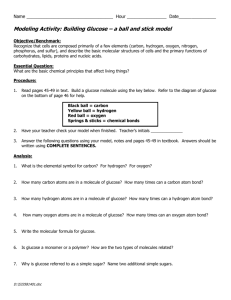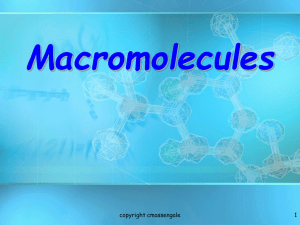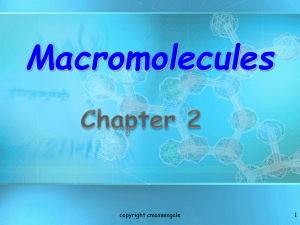The Chemistry of Life
advertisement
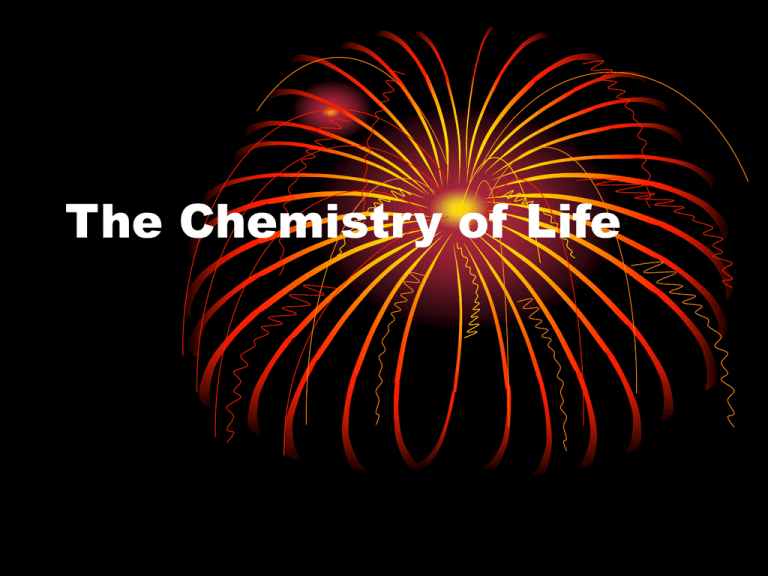
The Chemistry of Life Learning Target • I can review basic chemistry properties and characteristics: • • • • • Atoms Subatomic particles Ions Chemical bonding Water The Nature of Matter • An atom is the basic unit of matter. • Protons and neutrons are in the nucleus • Electrons surround the nucleus Atoms • Protons are + charged • Electrons are – charged • Neutrons have 0 charge • Have equal numbers of protons and electrons Elements • A pure substance that is made of only one type of atom • Over 100 are known • 90 or so are natural • About 24 are found in living organisms Elements • Represented by a one or two letter symbol • H is hydrogen • Na is sodium • All elements are arranged on the Periodic Table of Elements I am Dmitri Mendeleev! I made the PERIODIC TABLE ! What is the PERIODIC TABLE? o Shows all known elements in the universe. o Organizes the elements by chemical properties. How do you read the PERIODIC TABLE? How do I find the number of protons, electrons, and neutrons in an element using the periodic table? o # of PROTONS = ATOMIC NUMBER o # of ELECTRONS = ATOMIC NUMBER o # of NEUTRONS = ATOMIC _ ATOMIC WEIGHT NUMBER Isotopes • Atoms of the same element with different numbers of neutrons Isotopes • Some are radioactive • The nuclei are unstable and break down at a constant rate • Carbon dating • Medical procedures Chemical Compounds • A substance formed by the chemical combination of two or more elements • H2O • NaCl • Physical and chemical properties of the compound are very different from the individual elements Electron Shells a) Electrons vary in the amount of energy they possess, and they occur at certain energy levels or electron shells. b) Electron shells determine how an atom behaves when it encounters other atoms Electrons are placed in shells according to rules: 1) The 1st shell can hold up to two electrons, and each shell thereafter can hold up to 8 electrons. Octet Rule = atoms tend to gain, lose or share electrons so as to have 8 electrons C would like to Gain 4 electrons N would like to Gain 3 electrons O would like to Gain 2 electrons IONIC BOND bond formed between two ions by the transfer of electrons 1). Ionic bond – electron from Na is transferred to Cl, this causes a charge imbalance in each atom. The Na becomes (Na+) and the Cl becomes (Cl-), charged particles or ions. COVALENT BOND bond formed by the sharing of electrons Covalent Bond • Between nonmetallic elements of similar electronegativity. • Formed by sharing electron pairs • Examples; O2, CO2, C2H6, H2O, SiC 2. Covalent bonds- Two atoms share one or more pairs of outer-shell electrons. Oxygen Atom Oxygen Atom Oxygen Molecule (O2) - water is a polar molecule because oxygen is more electronegative than hydrogen, and therefore electrons are pulled closer to oxygen. The Extraordinary Properties of Water Water • A water molecule (H2O), is made up of three atoms --one oxygen and two hydrogen. H H O Water is Polar • In each water molecule, the oxygen atom attracts more than its "fair share" of electrons • The oxygen end “acts” negative • The hydrogen end “acts” positive • Causes the water to be POLAR • However, Water is neutral (equal number of e- and p+) --- Zero Net Charge Hydrogen Bonds Exist Between Water Molecules • Formed between a highly Electronegative atom of a polar molecule and a Hydrogen • One hydrogen bond is weak , but many hydrogen bonds are strong Interaction Between Water Molecules Negative Oxygen end of one water molecule is attracted to the Positive Hydrogen end of another water molecule to form a HYDROGEN BOND What are the Properties of Water? Properties of Water • At sea level, pure water boils at 100 °C and freezes at 0 °C. • The boiling temperature of water decreases at higher elevations (lower atmospheric pressure). • For this reason, an egg will take longer to boil at higher altitudes Properties of Water • Cohesion Properties of Water • Cohesion • Adhesion Properties of Water • Cohesion • Adhesion • High Specific Heat Properties of Water • Cohesion • Adhesion • High Specific Heat • High Heat of Vaporization Properties of Water • Cohesion • Adhesion • High Specific Heat • High Heat of Vaporization • Less Dense as a Solid Cohesion • Attraction between particles of the same substance ( why water is attracted to itself) • Results in Surface tension (a measure of the strength of water’s surface) • Produces a surface film on water that allows insects to walk on the surface of water Cohesion … Helps insects walk across water Adhesion • Attraction between two different substances. • Water will make hydrogen bonds with other surfaces such as glass, soil, plant tissues, and cotton. • Capillary action-water molecules will “tow” each other along when in a thin glass tube. • Example: transpiration process which plants and trees remove water from the soil, and paper towels soak up water. Adhesion Causes Capillary Action Which gives water the ability to “climb” structures Adhesion Also Causes Water to … Form spheres & hold onto plant leaves Attach to a silken spider web High Specific Heat • Amount of heat needed to raise or lower 1g of a substance 1° C. • Water resists temperature change, both for heating and cooling. • Water can absorb or release large amounts of heat energy with little change in actual temperature. High Heat of Vaporization • Amount of energy to convert 1g or a substance from a liquid to a gas • In order for water to evaporate, hydrogen bonds must be broken. • As water evaporates, it removes a lot of heat with it. High Heat of Vaporization • Water's heat of vaporization is 540 cal/g. • In order for water to evaporate, each gram must GAIN 540 calories (temperature doesn’t change --100oC). • As water evaporates, it removes a lot of heat with it (cooling effect). • Water vapor forms a kind of global ‘‘blanket” which helps to keep the Earth warm. • Heat radiated from the sun warmed surface of the earth is absorbed and held by the vapor. Water is Less Dense as a Solid • Ice is less dense as a solid than as a liquid (ice floats) • Liquid water has hydrogen bonds that are constantly being broken and reformed. • Frozen water forms a crystal-like lattice whereby molecules are set at fixed distances. Water is Less Dense as a Solid •Which is ice and which is water? Water is Less Dense as a Solid Water Ice Homeostasis • Ability to maintain a steady state despite changing conditions • Water is important to this process because: a. Makes a good insulator b. Resists temperature change c. Universal solvent d. Coolant e. Ice protects against temperature extremes (insulates frozen lakes) Learning Target • I can review basic chemistry properties and characteristics: • • • • • • Atoms Subatomic particles Ions Chemical bonding Water pH scale Learning Targets • I can explain the fundamental principles of the pH scale and the consequences of having the different concentrations of hydrogen and hydroxide ions. Solutions & Suspensions • Water is usually part of a mixture. • There are two types of mixtures: • Solutions • Suspensions Solution • Ionic compounds disperse as ions in water • Evenly distributed • SOLUTE • Substance that is being dissolved • SOLVENT • Substance into which the solute dissolves Solution Suspensions • Substances that don’t dissolve but separate into tiny pieces. • Water keeps the pieces suspended so they don’t settle out. Acids, Bases and pH One water molecule in 550 million naturally dissociates into a Hydrogen Ion (H+) and a Hydroxide Ion (OH-) H2O H+ Hydrogen Ion Acid + OH - Hydroxide Ion Base The pH Scale • Indicates the concentration of H+ ions • Ranges from 0 – 14 • pH of 7 is neutral • pH 0 up to 7 is acid … H+ • pH above 7 – 14 is basic… OH• Each pH unit represents a factor of 10X change in concentration • pH 3 is 10 x 10 x 10 (1000) stronger than a pH of 6 Acids • Strong Acids have a pH of 1-3 • Produce lots of H+ ions Bases • Strong Bases have a pH of 11 to 14 • Contain lots of OHions and fewer H+ ions Buffers • Weak acids or bases that react with strong acids or bases to prevent sharp, sudden changes in pH (neutralization). • Produced naturally by the body to maintain homeostasis Weak Acid Weak Base Learning Targets • I can explain the fundamental principles of the pH scale and the consequences of having the different concentrations of hydrogen and hydroxide ions. Learning Targets • I can describe the general structure and function including common functional groups of monosaccharides, disaccharides, polysaccharides, carbohydrates, fatty acids, glycerol, lipids, amino acids, dipeptides, polypeptides, proteins and nucleic acids. Carbon Compounds • Compounds that contain CARBON are called organic. • Macromolecules are large organic molecules. copyright cmassengale 65 Carbon (C) • Carbon has 4 electrons in outer shell. • Carbon can form covalent bonds with as many as 4 other atoms (elements). • Usually with C, H, O or N. copyright cmassengale 66 Macromolecules • Large organic molecules. • Also called POLYMERS. • Made up of smaller “building blocks” called MONOMERS. • Examples: 1. Carbohydrates 2. Lipids 3. Proteins 4. Nucleic acids (DNA and RNA) copyright cmassengale 67 How are macromolecules made? • Condensation (dehydration) reactions are reactions that remove a molecule of water from two monomers to make a larger polymer Carbohydrates copyright cmassengale 69 Carbohydrate Functions • Provide energy for cells and organisms • Provide structure to cells, especially plant cells Carbohydrates • Small sugar molecules to large sugar molecules. • Examples: A.monosaccharide B. disaccharide C. polysaccharide copyright cmassengale 71 Carbohydrates Monosaccharide: one sugar unit Examples: glucose (C6H12O6) fructose galactose deoxyribose ribose glucose copyright cmassengale 72 Carbohydrates Disaccharide: two sugar unit Examples: • Sucrose (glucose+fructose) • Lactose (glucose+galactose) • Maltose (glucose+glucose) glucose glucose copyright cmassengale 73 Carbohydrates Polysaccharide: many sugar units Examples: starch (bread, potatoes) glycogen (beef muscle) cellulose (lettuce, corn) glucose glucose glucose glucose cellulose glucose glucose glucose copyright cmassengale glucose 74 Lipids copyright cmassengale 75 Lipids • General term for compounds which are not soluble in water. • Lipids are soluble in hydrophobic solvents. • Remember: “stores the most energy” • Examples: 1. Fats 2. Phospholipids 3. Oils 4. Waxes 5. Steroid hormones cmassengale 6. copyright Triglycerides 76 Lipids Functions of lipids: 1.Long term energy storage 2.Major component of cell membranes 3.Protection against heat loss, physical shock, water loss copyright cmassengale 77 Lipids Triglycerides: composed of 1 glycerol and 3H fatty acids. O H-C----O C-CH2-CH2-CH2-CH2-CH2-CH2-CH2-CH2-CH2-CH3 O H-C----O C-CH2-CH2-CH2-CH2-CH2-CH2-CH2-CH2-CH2-CH3 O fatty acids H-C----O C-CH -CH -CH -CH 2 2 2 H glycerol copyright cmassengale 78 Fatty Acids There are two kinds of fatty acids you may see these on food labels: 1. Saturated fatty acids: no double bonds (bad) O C-CH2-CH2-CH2-CH2-CH2-CH2-CH2-CH2-CH2-CH3 saturated 2. Unsaturated fatty acids: double bonds (good) unsaturated O C-CH2-CH2-CH2-CH copyright cmassengale 79 Proteins copyright cmassengale 80 Proteins (Polypeptides) • Amino acids (20 different kinds of aa) bonded together by peptide bonds (polypeptides). • Functions of proteins: 1.Control rates of chemical reactions 2.Regulate cell processes 3.Transport materials into and out of cells 4.Forms bones and muscles copyright cmassengale 81 Proteins • Contain N, C, H, O • Each has an amino group and a carboxyl group on each end • Has an R group that makes it the specific amino acid it is Nucleic Acids copyright cmassengale 83 Nucleic acids • Two types: a. Deoxyribonucleic acid (DNAdouble helix) b. Ribonucleic acid (RNA-single strand) Each is composed of a nucleotide copyright cmassengale 84 Nucleic acids • Nucleotides include: phosphate group pentose sugar (5-carbon) nitrogenous bases: adenine (A) thymine (T) DNA only uracil (U) RNA only cytosine (C) guanine (G) copyright cmassengale 85 Nucleotide Phosphate Group O O=P-O O 5 CH2 O N C1 C4 Nitrogenous base (A, G, C, or T) Sugar (deoxyribose) C3copyright cmassengale C2 86 Learning Targets • I can describe the general structure and function including common functional groups of monosaccharides, disaccharides, polysaccharides, carbohydrates, fatty acids, glycerol, lipids, amino acids, dipeptides, polypeptides, proteins and nucleic acids. Learning Targets • I can show how chemical reactions can be represented by chemical formulas. • I can describe the function of enzymes, including how enzyme-substrate specificity works, in biochemical reactions. Chemical Reactions • A process that changes one group of chemicals into another. CO2 + H2O H2CO3 Reactants Product Chemical Reactions • http://www.youtube.com/watch? v=66kuhJkQCVM • http://www.youtube.com/watch? v=m8mbGH6b2cg Energy in Reactions • Chemical reactions can release or absorb energy • The ones that release energy can happen spontaneously • The ones that absorb energy won’t happen with a source of energy Energy in Reactions • Activation energy is the energy needed to get a reaction started. • The rate or how fast the reaction occurs depends on catalysts. Energy in Reactions • A catalyst is something that speeds up the rate of the reaction. • Often a catalyst is a special protein called an enzyme. Enzymes • Proteins that act as biological catalysts. • Enzymes are very specific; catalyzing only one chemical reaction. • Often end is “ase” Enzyme-Substrate Complex • Enzymes provide a site where reactants can be brought together. • Reactants are known as substrates. • The substrate fits into the active site on the enzyme to start the reaction. Energy in Reactions • Enzymes lower a reaction’s activation energy • http://www.youtube.com/watch? v=VbIaK6PLrRM Learning Target • I can show how chemical reactions can be represented by chemical formulas. • I can describe the function of enzymes, including how enzyme-substrate specificity works, in biochemical reactions.



